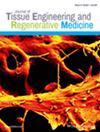基于人脂肪组织源性间充质基质细胞的人工淋巴血管组织移植对小鼠淋巴引流的促进作用
IF 3.1
3区 生物学
Q2 BIOTECHNOLOGY & APPLIED MICROBIOLOGY
Journal of Tissue Engineering and Regenerative Medicine
Pub Date : 2023-11-06
DOI:10.1155/2023/7626767
引用次数: 0
摘要
利用淋巴血管工程进行再生医学是治疗淋巴水肿的一种很有前途的方法。但其发展滞后于用于缺血性疾病的人工血管组织。在这项研究中,我们通过共同培养ecm纳米膜包裹的人脂肪组织来源的间充质基质细胞(hASCs)和人真皮淋巴内皮细胞(HDLECs),构建了人工三维淋巴血管组织,称为ASCLT。通过与基于成纤维细胞的组织(称为FbLT)进行比较,评估了hASCs在淋巴管网络形成中的作用。我们的研究结果显示,ASCLT的淋巴血管网络密度高于FbLT,表明hASCs对淋巴血管形成有促进作用。与FbLT相比,ASCLT中更高水平的淋巴管生成促进因子(如bFGF、HGF和VEGF-A)也支持了这一结果。为了评估治疗效果,我们将fblt和asclt通过去除腘窝和髂下淋巴结皮下移植到小鼠后肢淋巴引流中断模型中。尽管淋巴管的植入受到限制,ASCLT促进了皮肤不规则和多样化淋巴引流的再生,如吲哚菁绿成像所示。此外,将ASCLT移植到腘窝淋巴结切除区也能实现淋巴引流再生。fitc -葡聚糖注射显示的组织学分析显示,引流位于比真皮肌浅的皮下区域。这些发现表明,ASCLT促进体内淋巴引流,hASCs可以作为组织工程治疗继发性淋巴水肿的自体来源。本文章由计算机程序翻译,如有差异,请以英文原文为准。
Lymphatic Drainage-Promoting Effects by Engraftment of Artificial Lymphatic Vascular Tissue Based on Human Adipose Tissue-Derived Mesenchymal Stromal Cells in Mice
Regenerative medicine using lymphatic vascular engineering is a promising approach for treating lymphedema. However, its development lags behind that of artificial blood vascular tissue for ischemic diseases. In this study, we constructed artificial 3D lymphatic vascular tissue, termed ASCLT, by co-cultivation of ECM-nanofilm-coated human adipose tissue-derived mesenchymal stromal cells (hASCs) and human dermal lymphatic endothelial cells (HDLECs). The effect of hASCs in lymphatic vessel network formation was evaluated by comparison with the tissue based on fibroblasts, termed FbLT. Our results showed that the density of lymphatic vascular network in ASCLT was higher than that in FbLT, demonstrating a promoting effect of hASCs on lymphatic vascular formation. This result was also supported by higher levels of lymphangiogenesis-promoting factors, such as bFGF, HGF, and VEGF-A in ASCLT than in FbLT. To evaluate the therapeutic effects, FbLTs and ASCLTs were subcutaneously transplanted to mouse hindlimb lymphatic drainage interruption models by removal of popliteal and subiliac lymph nodes. Despite the restricted engraftment of lymphatic vessels, ASCLT promoted regeneration of irregular and diverse lymphatic drainage in the skin, as visualized by indocyanine green imaging. Moreover, transplantation of ASCLT to the popliteal lymph node resection area also resulted in lymphatic drainage regeneration. Histological analysis of the generated drainage visualized by FITC-dextran injection revealed that the drainage was localized in the subcutaneous area shallower than the dermal muscle. These findings demonstrate that ASCLT promotes lymphatic drainage in vivo and that hASCs can serve as an autologous source for treatment of secondary lymphedema by tissue engineering.
求助全文
通过发布文献求助,成功后即可免费获取论文全文。
去求助
来源期刊
CiteScore
7.50
自引率
3.00%
发文量
97
审稿时长
4-8 weeks
期刊介绍:
Journal of Tissue Engineering and Regenerative Medicine publishes rapidly and rigorously peer-reviewed research papers, reviews, clinical case reports, perspectives, and short communications on topics relevant to the development of therapeutic approaches which combine stem or progenitor cells, biomaterials and scaffolds, growth factors and other bioactive agents, and their respective constructs. All papers should deal with research that has a direct or potential impact on the development of novel clinical approaches for the regeneration or repair of tissues and organs.
The journal is multidisciplinary, covering the combination of the principles of life sciences and engineering in efforts to advance medicine and clinical strategies. The journal focuses on the use of cells, materials, and biochemical/mechanical factors in the development of biological functional substitutes that restore, maintain, or improve tissue or organ function. The journal publishes research on any tissue or organ and covers all key aspects of the field, including the development of new biomaterials and processing of scaffolds; the use of different types of cells (mainly stem and progenitor cells) and their culture in specific bioreactors; studies in relevant animal models; and clinical trials in human patients performed under strict regulatory and ethical frameworks. Manuscripts describing the use of advanced methods for the characterization of engineered tissues are also of special interest to the journal readership.

 求助内容:
求助内容: 应助结果提醒方式:
应助结果提醒方式:


